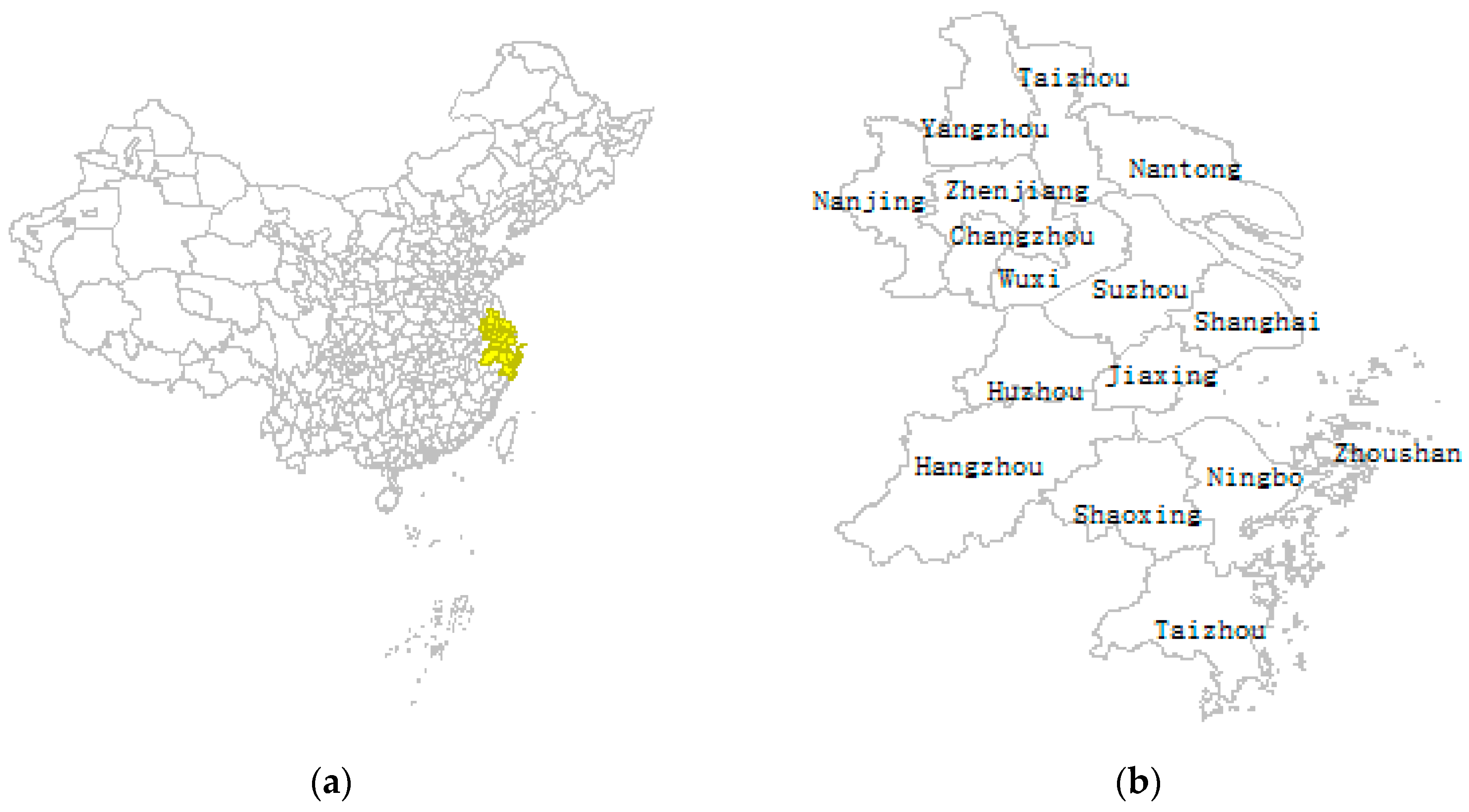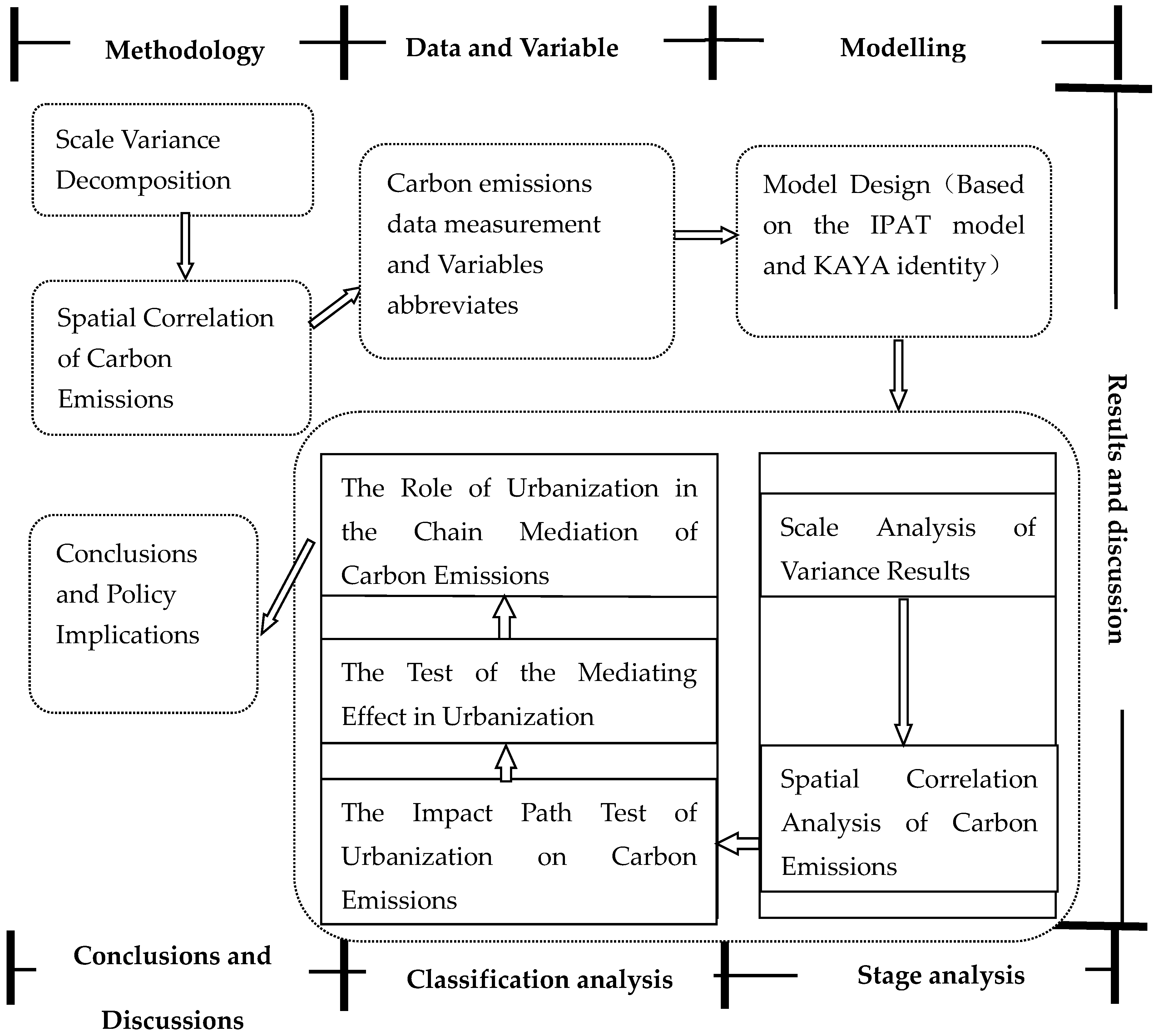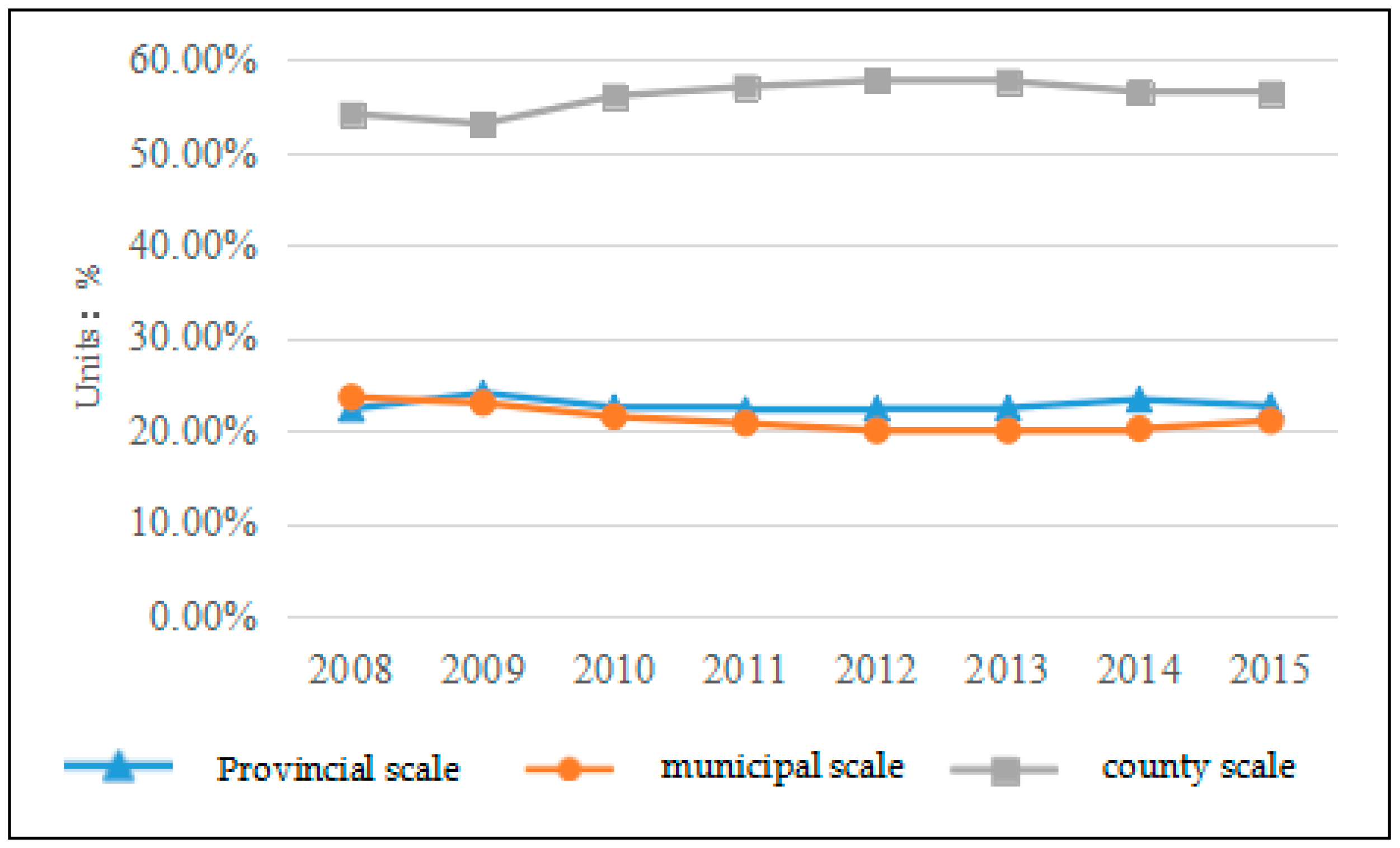An Empirical Study on the Impact Path of Urbanization to Carbon Emissions in the China Yangtze River Delta Urban Agglomeration
Abstract
:1. Introduction
2. Methodology and Data
2.1. Methodology
2.1.1. Scale Variance Decomposition
2.1.2. Spatial Correlation of Carbon Emissions
2.2. Data
2.2.1. Carbon Emissions Data Measurement
2.2.2. Variables abbreviates
2.3. Model Design
3. Results and Analysis
3.1. Scale Analysis of Variance Results
3.2. Spatial Correlation Analysis of Carbon Emissions
3.3. The Impact Path Test of Urbanization on Carbon Emissions
3.4. The Test of the Mediating Effect in Urbanization
3.5. The role of urbanization in the chain mediation of carbon emissions
4. Conclusions and Discussions
4.1. Conclusions
4.2. Discussions
4.2.1. Discussion on the Results of Scale Variance Decomposition
4.2.2. Discussion on the Results of Spatial Analysis of Carbon Emissions
4.2.3. Discussion on the Results of the Significant Impact Path of Urbanization on Carbon Emissions
4.3. Policy Implications
Author Contributions
Acknowledgments
Conflicts of Interest
References
- Dong, F.; Yu, B.; Hadachin, T.; Dai, Y.; Wang, Y. Drivers of carbon emission intensity change in China. Resour. Conserv. Recycl. 2018, 129, 187–201. [Google Scholar] [CrossRef]
- Johnson, H.E.; Sushinsky, J.R.; Holland, A.; Bergman, E.J.; Balzer, T. Increases in Residential and Energy Development are Associated with Reductions in Recruitment for a Large Ungulate. Glob. Chang. Biol. 2017, 2, 578–591. [Google Scholar] [CrossRef] [PubMed]
- Zhang, Y.J.; Yi, W.C.; Li, B.W. The Impact of Urbanization on Carbon Emission: Empirical Evidence in Beijing. Energy Procedia 2015, 75, 2963–2968. [Google Scholar] [CrossRef] [Green Version]
- Ren, L.; Wang, W.; Wang, J.; Liu, R. Analysis of Energy Consumption and Carbon Emission during the Urbanization of Shandong Province, China. J. Clean. Prod. 2015, 103, 534–541. [Google Scholar] [CrossRef]
- Sheng, P.; Guo, X. The Long-Run and Short-Run Impacts of Urbanization on Carbon Dioxide Emissions. Econ. Model. 2016, 53, 208–215. [Google Scholar] [CrossRef]
- Li, K.; Lin, B. Impacts of Urbanization and Industrialization on Energy Consumption/Emissions: Does the Level of Development Matter? Renew. Sustain. Energy Rev. 2015, 52, 1107–1122. [Google Scholar] [CrossRef]
- Dong, X.; Yuan, G. China’s Greenhouse Gas Emissions Dynamic Effects in the Process of Its Urbanization: A Perspective from Shocks Decomposition under Long-Term Constraints. Energy Procedia 2011, 5, 1660–1665. [Google Scholar]
- Li, C.; Kuang, Y.; Huang, N.; Zhang, C. The Long-Term Relationship between Population Growth and Vegetation Cover: An Empirical Analysis Based on the Panel Data of 21 Cities in Guangdong Province, China. Int. J. Environ. Res. Public Health 2013, 2, 660–677. [Google Scholar] [CrossRef] [PubMed]
- Cole, M.; Neumayer, E. Examining the Impact of Demographic Factors on Air Pollution. Popul. Environ. 2004, 1, 5–21. [Google Scholar] [CrossRef]
- Yang, Y.; Zhao, T.; Wang, Y.; Shi, Z. Research on Impacts of Population-Related Factors on Carbon Emissions in Beijing from 1984 to 2012. Environ. Impact Assess. Rev. 2015, 55, 45–53. [Google Scholar] [CrossRef]
- Wang, H.; Wang, Y.; Wang, H.; Liu, M.; Zhang, Y. Mitigating Greenhouse Gas Emissions from China’s Cities: Case Study of Suzhou. Energy Policy 2014, 68, 482–489. [Google Scholar] [CrossRef]
- York, R. Demographic Trends and Energy Consumption in European Union Nations, 1960–2025. Soc. Sci. Res. 2007, 3, 855–872. [Google Scholar] [CrossRef]
- Liddle, B.; Lung, S. Age-Structure, Urbanization, and Climate Change in Developed Countries: Revisiting Stirpat for Disaggregated Population and Consumption-Related Environmental Impacts. Popul. Environ. 2010, 5, 317–343. [Google Scholar] [CrossRef]
- Wang, Y.; Li, L.; Kubota, J.; Han, R.; Zhu, X. Does Urbanization Lead to More Carbon Emission? Evidence from a Panel of Brics Countries. Appl. Energy 2016, 168, 375–380. [Google Scholar] [CrossRef]
- York, R.; Rosa, E.A.; Dietz, T. A Rift in Modernity? Assessing the Anthropogenic Sources of Global Climate Change with the Stirpat Model. Int. J. Sociol. Soc. Policy 2003, 10, 31–51. [Google Scholar] [CrossRef]
- Sharma, S.S. Determinants of Carbon Dioxide Emissions: Empirical Evidence from 69 Countries. Appl. Energy 2011, 1, 376–382. [Google Scholar] [CrossRef]
- Xu, H.; Zhang, W. The Causal Relationship between Carbon Emissions and Land Urbanization Quality: A Panel Data Analysis for Chinese Provinces. J. Clean. Prod. 2016, 137, 241–248. [Google Scholar] [CrossRef]
- Ali, H.S.; Abdul-Rahim, A.S.; Ribadu, M.B. Urbanization and Carbon Dioxide Emissions in Singapore: Evidence from the Ardl Approach. Environ. Sci. Pollut. Res. Int. 2017, 2, 1967–1974. [Google Scholar] [CrossRef]
- Asumadu-Sarkodie, S.; Owusu, P.A. A Multivariate Analysis of Carbon Dioxide Emissions, Electricity Consumption, Economic Growth, Financial Development, Industrialization, and Urbanization in Senegal. Energy Sources Part Econ. Plan. Policy 2017, 1, 77–84. [Google Scholar] [CrossRef]
- Wang, S.; Fang, C.; Guan, X.; Pang, B.; Ma, H. Urbanisation, Energy Consumption, and Carbon Dioxide Emissions in China: A Panel Data Analysis of China’s Provinces. Appl. Energy 2014, 136, 738–749. [Google Scholar] [CrossRef]
- Wang, Y.; Chen, L.; Kubota, J. The Relationship Between Urbanization, Energy Use and Carbon Emissions: Evidence from a Panel of Association of Southeast Asian Nations (Asean) Countries. J. Clean. Prod. 2016, 112, 1368–1374. [Google Scholar] [CrossRef]
- Ouyang, X.; Lin, B. Carbon Dioxide Emissions during Urbanization: A Comparative Study Between China and Japan. J. Clean. Prod. 2017, 143, 356–368. [Google Scholar] [CrossRef]
- Zhang, Z.; Zhao, Y.; Su, B.; Zhang, Y. Embodied Carbon in China’s Foreign Trade: An Online Sci-E and Ssci Based Literature Review. Renew. Sustain. Energy Rev. 2017, 1, 492–510. [Google Scholar] [CrossRef]
- Pacheco-Torres, R.; Roldan, J.; Gago, E.J.; Ordonez, J. Assessing the Relationship between Urban Planning Options and Carbon Emissions at the Use Stage of New Urbanized Areas: A Case Study in Warm Climate Location. Energy Build. 2017, 136, 73–85. [Google Scholar] [CrossRef]
- Wang, S.; Fang, C.; Ma, H.T. Spatial Differences and Multi-Mechanism of Carbon Footprint Based on Gwr Model in Provincial China. J. Geogr. Sci. 2014, 4, 612–630. [Google Scholar] [CrossRef]
- Xiong, C.; Yang, D.; Huo, J. Spatial-Temporal Characteristics and Lmdi-Based Impact Factor Decomposition of Agricultural Carbon Emissions in Hotan Prefecture, China. Sustainability 2016, 8, 262. [Google Scholar] [CrossRef]
- Videras, J. Exploring Spatial Patterns of Carbon Emissions in the USA: A Geographically Weighted Regression Approach. Popul. Environ. 2014, 2, 137–154. [Google Scholar] [CrossRef]
- Wang, F.; Gao, M.; Liu, J.; Fan, W. The Spatial Network Structure of China’s Regional Carbon Emissions and Its Network Effect. Energies 2018, 11, 2706. [Google Scholar] [CrossRef]
- Pan, H.; Deal, B.; Chen, Y. A Reassessment of urban structure and land-use patterns: Distance to CBD or network-based?—Evidence from Chicago. Region. Sci. Urban Econ. 2018, 70, 215–228. [Google Scholar] [CrossRef]
- Seto, K.C.; Shepherd, J.M. Global urban land-use trends and climate impacts. Curr. Opin. Environ. Sustain. 2009, 1, 89–95. [Google Scholar] [CrossRef]
- Hu, Y.; Jia, G.; Pohl, C. Improved monitoring of urbanization processes in China for regional climate impact assessment. Environ. Earth Sci. 2015, 12, 8387–8404. [Google Scholar] [CrossRef]
- Cushman, S.A.; Mcgarigal, K. Hierarchical, Multi-scale decomposition of species-environment relationships. Landsc. Ecol. 2002, 7, 637–646. [Google Scholar] [CrossRef]
- Cai, B.; Yu, R. Comparison on Spatial Scale Analysis Methods in Landscape Ecology. Acta Ecol. Sin. 2008, 5, 2279–2287. [Google Scholar]
- José, M.; María, L. Driving forces of Spain’s CO2 emissions: A LMDI decomposition approach. Renew. Sustain. Energy Rev. 2015, 48, 749–759. [Google Scholar]
- Jung, S.; Kyoungjin, A.N. Regional energy-related carbon emission characteristics and potential mitigation in eco-industrial parks in South Korea: Logarithmic mean Divisia index analysis based on the Kaya identity. Energy 2012, 1, 231–241. [Google Scholar] [CrossRef]
- Budzianowski, W.M. Modelling of CO2 content in the atmosphere until 2300: Influence of energy intensity of gross domestic product and carbon intensity of energy. Inter. J. Glob. Warm. 2013, 1, 1–17. [Google Scholar] [CrossRef]
- Hu, J.; Jiang, X. Study on the Influence of Urbanization on Carbon Emissions from the Perspective of Urban Agglomeration. J. China Univ. Geosci. 2015, 6, 11–21. [Google Scholar]
- Chuntao, W.U. The Impact of Urbanization on Agricultural Carbon Emissions in China—An Empirical Study Based on Provincial Data. Econ. Surv. 2015, 1, 12–18. [Google Scholar]
- Wang, G. Urbanization: Focus of the Transformation of China’s Economic Development Model. Econ. Res. 2010, 12, 43–59. [Google Scholar]
- Tao, A.; Yang, S.; Li, Y. The Impact of Urbanization Quality on the Spatial Effects of Carbon Emissions: A Case Study of 16 Cities in the Yangtze River Delta Region. Urban Probl. 2016, 12, 11–18. [Google Scholar]
- Huo, B. Research on the Influencing Factors of the Differences of Urbanization Development in China: Based on the Empirical Analysis of Provincial Panel Data from 1992 to 2015. Inq. Econ. Issues 2017, 4, 76–82. [Google Scholar]
- Yang, G.; Wu, Q.; Tu, Y. Researchs of China’s Regional Carbon Emission Spatial Correlation and Its Determinants: Based on the Method of Social Network Analysis. J. Bus. Econ. 2016, 4, 56–68. [Google Scholar]




| Spatial Scale | Degree of Freedom | The Composition of the Scale Variance |
|---|---|---|
| Types of Energy | Coal | Coke | Crude Oil | Gasoline | Kerosene | Diesel | Fuel Oil | Natural Gas |
|---|---|---|---|---|---|---|---|---|
| Standard Coal Conversion Coefficient | 0.7143 | 0.9714 | 1.4286 | 1.4714 | 1.4717 | 1.4571 | 1.4286 | 1.3300 |
| Carbon Emissions Coefficient (tc/tce) | 0.7559 | 0.8550 | 0.5857 | 0.5538 | 0.5714 | 0.5921 | 0.6185 | 0.4226 |
| Variable | Represents |
|---|---|
| lnCi | lnC1 or lnC2 |
| lnY (total) | the total effect regression equation |
| lnU | the mediating effect regression equation |
| lnY | the direct effect regression equation |
| lnY(1) | the total effect of the regression equation |
| lnY(2) | the direct effect of the regression equation |
| lnC1 | The proportion of secondary industry |
| lnC2 | The proportion of tertiary industry |
| lnG | Economic development level |
| Inspection Type | Statistical Model | Statistical Value |
|---|---|---|
| LR test | Spatial lag | 8.716 [0] *** |
| Spatial error | 40.613 [0] *** | |
| Wald test | Spatial lag | 9.409 [0] *** |
| Spatial error | 87.116 [0] *** | |
| Hausman test | 39.529 [0] *** | |
| The Adjacent Spatial Weight Matrix | The Economic Distance Weight Matrix | |
|---|---|---|
| 2008 | −0.009 [0.110] | 0.014 [0] *** |
| 2009 | −0.009 [0.110] | 0.014 [0] *** |
| 2010 | −0.010 [0.150] | 0.014 [0] *** |
| 2011 | −0.009 [0.008] *** | 0.014 [0] *** |
| 2012 | −0.009 [0.131] | 0.013 [0] *** |
| 2013 | −0.009 [0.160] | 0.013 [0] *** |
| 2014 | −0.009 [0.160] | 0.013 [0] *** |
| 2015 | 0.003 [0.130] | 0.013 [0] *** |
| Urbanization (lnU)→The Proportion of Secondary Industry (lnC1)→Carbon Emission (lnY) | Urbanization (lnU)→The Proportion of tertiary Industry (lnC2)→Carbon Emission (lnY) | Urbanization (lnU)→ Economic Development Level (lnG)→Carbon Emission (lnY) | |||||||
|---|---|---|---|---|---|---|---|---|---|
| lnY(total) | LnC1 | lnY | lnY(total) | lnC2 | lnY | lnY(total) | lnG | lnY | |
| Column1 | Column2 | Column3 | Column4 | Column5 | Column6 | Column7 | Column8 | Column9 | |
| lnG | 0.085 [0] *** | 0.072 [0] *** | 0.071 [0] *** | 0.085 [0] *** | 0.208 [0.545] | 0.087 [0] *** | 0.085 [0] *** | ||
| lnP | 0.820 [0] *** | 0.793 [0] *** | 0.820 [0] *** | 0.786 [0] *** | 0.881 [0] *** | 0.820 [0] *** | |||
| lnT | 0.828 [0] *** | 0.805 [0] *** | 0.828 [0] *** | 0.819 [0] *** | 0.757 [0] *** | 0.828 [0] *** | |||
| lnU | 0.044 [0.014] ** | 0.035 [0.001] *** | 0.071 [0] *** | 0.044 [0.014] *** | 0.028 [0.014] ** | 0.056 [0.002] ** | 0.167 [0] *** | 0.959 [0.014] ** | 0.044 [0.014] *** |
| lnCi | 0.175 | 0.013 | |||||||
| [0] *** | [0.038] ** | ||||||||
| W*lnY | 0.413 [0] *** | 0.641 [0] *** | 0.413 [0] *** | 0.363 [0] *** | 0.623 [0] *** | 0.413 [0] *** | |||
| W*lnG | 0.175 [0] *** | 0.188 [0.031] ** | 0.119 [0] *** | 0.012 [0.452] | 0.063 [0] *** | 0.012 [0.452] | |||
| W*lnP | 0.002 [0.991] | 0.002 [0.991] | −0.456 [0] ** | 0.002 [0.991] | |||||
| W*lnT | −0.105 [0.013] ** | −0.105 [0.013] ** | −0.323 [0] *** | −0.105 [0.013] ** | |||||
| W*lnU | −0.088 [0.079] * | −0.025 [0.536] | 0.113 [0.004] *** | −0.088 [0.079] * | 0.048 [0.169] | −0.129 [0.006] *** | 0.123 [0] *** | 0.048 [0.169] | −0.088 [0.079] * |
| W*lnCi | 0.175 [0] *** | −0.188 [0.031] ** | 0.125 [0.022] ** | 0.308 [0.007] *** | |||||
| R2 | 99.66% | 87.85% | 99.67% | 99.66% | 94.58% | 99.61% | 99.57% | 94.58% | 99.66% |
| The Proportion of Secondary Industry→ Urbanization→ Carbon Emission | The Proportion of Tertiary Industry→ Urbanization→ Carbon Emission | Economic Development Level→ Urbanization→ Carbon Emission | |||||||
|---|---|---|---|---|---|---|---|---|---|
| lnY(total) | lnU | lnY | lnY(total) | lnU | lnY | lnY(total) | lnU | lnY | |
| Column1 | Column2 | Column3 | Column4 | Column5 | Column6 | Column7 | Column8 | Column9 | |
| lnCi | −0.285 [0.159] | 0.099 [0.069] * | −1.700 [0.728] | 1.482 [0.022] ** | |||||
| lnG | 1.867 [0.001] | 1.728 [0.001] *** | −5.437 [0] *** | 1.762 [0.005] *** | 0.847 [0] *** | 0.074 [0] *** | 0.828 [0] *** | ||
| lnT | 0.752 [0.048] | 0.718 [0.049] ** | 0.768 [0.025] ** | 0.084 [0] *** | 0.085 [0] *** | ||||
| lnP | 3.478 [0.001] | 3.041 [0.016] ** | 3.556 [0.002] *** | 0.814 [0] *** | 0.821 [0] *** | ||||
| lnU | 0.033 [0.608] | 0.167 [0] *** | 0.622 [0] *** | ||||||
| W*lnY | 0.268 [0.035] | 0.448 [0.044] ** | 0.441 [0.046] ** | 0.401 [0] *** | 0.385 [0] *** | ||||
| W*lnCi | −1.585 [0.286] | 3.216 [0.105] | 0.012 [0.452] | ||||||
| W*lnG | 0.617 [0.030] ** | 0.017 [0.391] | −0.105 [0.013] ** | 0.012 [0.442] | 0.013 [0.652] | 0.016 [0.307] | |||
| W*lnT | 2.069 [0.131] * | 0.002 [0.991] | −0.323 [0] *** | −0.266 [0] *** | |||||
| W*lnP | −0.456 [0] *** | −0.002 [0.116] | −0.456 [0] ** | 0.002 [0.991] | |||||
| W*lnU | 0.099 [0.069] * | −1.700 [0.728] | 1.482 [0.022] ** | 0.135 [0] *** | −0.087 [0.062] * | ||||
| R2 | 97.76% | 99.43% | 81.03% | 99.12% | 99.46% | 96.95% | 99% | ||
| lnY(1) | lnY(2) | lnY(3) | lnG(1) | lnG(2) | lnS | |
|---|---|---|---|---|---|---|
| Column1 | Column2 | Column3 | Column4 | Column5 | Column6 | |
| lnG | 0.084 [0] *** | |||||
| lnP | 0.899 [0] *** | 0.899 [0] *** | 0.819 [0] *** | 0.362 [0] *** | 0.354 [0] *** | 0.083 [0.467] |
| lnU | 0.038 [0.060] * | 0.034 [0.089] * | 0.042 [0.021] ** | 0.243 [0] *** | 0.219 [0.002] *** | 0.427 [0] *** |
| lnT | 0.781 [0] *** | 0.052 [0.048] ** | 0.827 [0] *** | 0.657 [0] *** | 0.664 [0] *** | |
| lnS | 0.011 [0.247] | 0.006 [0.494] | 0.098 [0.054] * | |||
| W*lnG | 0.015 [0.323] | 0.341 [0] *** | 0.332 [0] *** | |||
| W*lnP | 0.569 [0.003] *** | 0.578 [0.003] *** | 0.374 [0.024] ** | 0.451 [0] *** | 0.489 [0] *** | −0.490 [0.441] |
| W*lnU | −0.066 [0.237] | −0.070 [0.215] | −0.085 [0.093] * | 0.447 [0] *** | 0.531 [0] *** | 0.304 [0.050] * |
| W*lnT | −0.436 [0] *** | −0.427 [0] *** | −0.266 [0] *** | 0.391 [0] *** | 0.384 [0] *** | |
| W*lnS | 0.0147 [0.462] | −0.005 [0.778] | 0.162 [0.113] | 0.044 [0.444] | ||
| W*lnY | 0.513 [0] *** | 0.503 [0] *** | 0.414 [0] *** | |||
| R2 | 99.58% | 99.68% | 99.66% | 96.75% | 97.72% | 71.92% |
© 2019 by the authors. Licensee MDPI, Basel, Switzerland. This article is an open access article distributed under the terms and conditions of the Creative Commons Attribution (CC BY) license (http://creativecommons.org/licenses/by/4.0/).
Share and Cite
Wang, F.; Gao, M.; Liu, J.; Qin, Y.; Wang, G.; Fan, W.; Ji, L. An Empirical Study on the Impact Path of Urbanization to Carbon Emissions in the China Yangtze River Delta Urban Agglomeration. Appl. Sci. 2019, 9, 1116. https://doi.org/10.3390/app9061116
Wang F, Gao M, Liu J, Qin Y, Wang G, Fan W, Ji L. An Empirical Study on the Impact Path of Urbanization to Carbon Emissions in the China Yangtze River Delta Urban Agglomeration. Applied Sciences. 2019; 9(6):1116. https://doi.org/10.3390/app9061116
Chicago/Turabian StyleWang, Feng, Mengnan Gao, Juan Liu, Yuhui Qin, Ge Wang, Wenna Fan, and Luxue Ji. 2019. "An Empirical Study on the Impact Path of Urbanization to Carbon Emissions in the China Yangtze River Delta Urban Agglomeration" Applied Sciences 9, no. 6: 1116. https://doi.org/10.3390/app9061116




